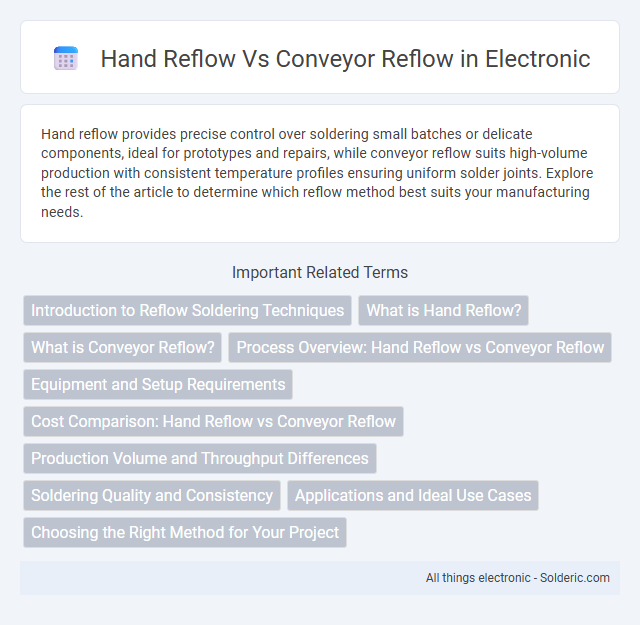Hand reflow provides precise control over soldering small batches or delicate components, ideal for prototypes and repairs, while conveyor reflow suits high-volume production with consistent temperature profiles ensuring uniform solder joints. Explore the rest of the article to determine which reflow method best suits your manufacturing needs.
Comparison Table
| Feature | Hand Reflow | Conveyor Reflow |
|---|---|---|
| Process Type | Manual soldering using a handheld heat source | Automated soldering using a conveyor oven |
| Temperature Control | Variable, based on operator skill | Precise, controlled via oven settings |
| Throughput | Low, suited for prototypes and small batches | High, ideal for mass production |
| Consistency | Inconsistent due to manual operation | Consistent, repeatable soldering quality |
| Cost | Lower initial investment, higher labor costs | Higher upfront cost, lower per-unit labor cost |
| Setup Time | Minimal setup time | Requires extensive setup and programming |
| Application | Used for prototypes, repairs, small-scale production | Used for consistent, large-scale PCB assembly |
Introduction to Reflow Soldering Techniques
Hand reflow soldering offers precision for small-scale or prototype PCB assembly, utilizing a handheld heat source to manually melt solder paste. Conveyor reflow soldering provides high-volume efficiency through automated heating zones that consistently reflow solder paste on PCBs moving along a belt. Your choice between these techniques depends on production volume, precision needs, and equipment availability.
What is Hand Reflow?
Hand reflow is a manual soldering process where a technician uses a handheld heat gun or soldering iron to melt solder paste on a printed circuit board (PCB) for component attachment. This technique is ideal for small-scale production, prototypes, or repairs due to its flexibility and control over heat application. Your choice of hand reflow can improve precision in localized areas compared to conveyor reflow, which is suited for higher volume automated assembly.
What is Conveyor Reflow?
Conveyor reflow is an automated soldering process where printed circuit boards (PCBs) pass through a heated tunnel on a moving conveyor belt to melt solder paste and securely attach electronic components. This method offers precise temperature control, consistent heating profiles, and higher throughput compared to manual hand reflow techniques. Conveyor reflow systems are essential in mass production environments, ensuring uniform solder joints and minimizing defects in surface mount technology (SMT) assembly.
Process Overview: Hand Reflow vs Conveyor Reflow
Hand reflow involves manually placing components on a PCB and using a handheld heat source, such as a soldering iron or hot air gun, to melt solder and secure connections. Conveyor reflow utilizes an automated process where PCBs pass through a temperature-controlled conveyor oven with precise thermal zones, ensuring uniform solder reflow across all components. This automated method enhances repeatability, throughput, and temperature control compared to the manual hand reflow process.
Equipment and Setup Requirements
Hand reflow requires minimal equipment, typically involving a simple hot air rework station and a small heating platform, making it ideal for prototyping and low-volume production. Conveyor reflow systems demand more complex setups, including precise conveyor belts, infrared or convection heating zones, and automated controls to ensure consistent soldering across high-volume PCB assemblies. The scalability and repeatability of conveyor reflow come at the cost of higher initial investment and floor space compared to the flexible, portable nature of hand reflow equipment.
Cost Comparison: Hand Reflow vs Conveyor Reflow
Hand reflow offers a low-cost solution ideal for small-scale or prototype PCB assembly, requiring minimal equipment investment and lower operational expenses. Conveyor reflow involves higher initial costs due to automated machinery but provides greater efficiency and consistency, leading to reduced labor costs and higher throughput. Your choice depends on balancing budget constraints with production volume and quality requirements.
Production Volume and Throughput Differences
Hand reflow soldering suits low production volumes due to its manual operation, resulting in slower throughput and limited consistency. Conveyor reflow systems excel in high-volume manufacturing, offering continuous processing with precise temperature control that enhances throughput and product uniformity. You should choose conveyor reflow for large-scale production needs, while hand reflow is ideal for prototyping or small batches.
Soldering Quality and Consistency
Hand reflow soldering often results in variable soldering quality due to manual temperature control and inconsistent heating times, leading to potential defects like cold joints or insufficient wetting. Conveyor reflow ovens provide precise, repeatable temperature profiles and controlled heating zones, ensuring uniform soldering quality and high consistency across large production volumes. Automated conveyor reflow minimizes human error and enhances process reliability, critical for maintaining stringent quality standards in surface-mount technology (SMT) assembly.
Applications and Ideal Use Cases
Hand reflow is ideal for low-volume production, prototyping, and repair tasks where precision and manual control are essential, typically used in small-scale electronics assembly and hobbyist projects. Conveyor reflow suits high-volume, automated manufacturing environments requiring consistent, repeatable soldering processes, such as in consumer electronics, automotive, and aerospace industries. The conveyor system offers enhanced throughput and uniform thermal profiles, making it optimal for mass production with complex PCBs.
Choosing the Right Method for Your Project
Hand reflow suits small-scale or prototype PCB assembly, offering precise control over individual components and lower setup costs. Conveyor reflow is ideal for high-volume production, providing consistent heat profiles and increased throughput with automated conveyor belts. Selecting the right method depends on project scale, budget constraints, and desired production speed to optimize efficiency and quality.
Hand reflow vs conveyor reflow Infographic

 solderic.com
solderic.com